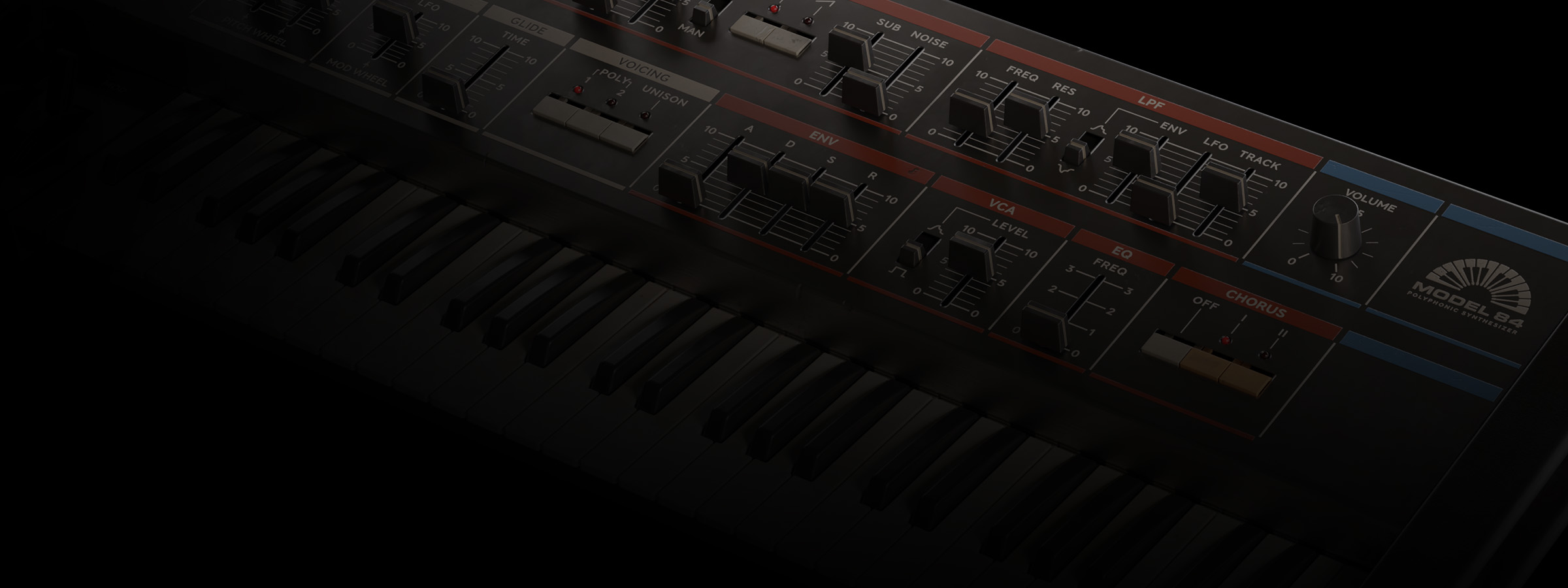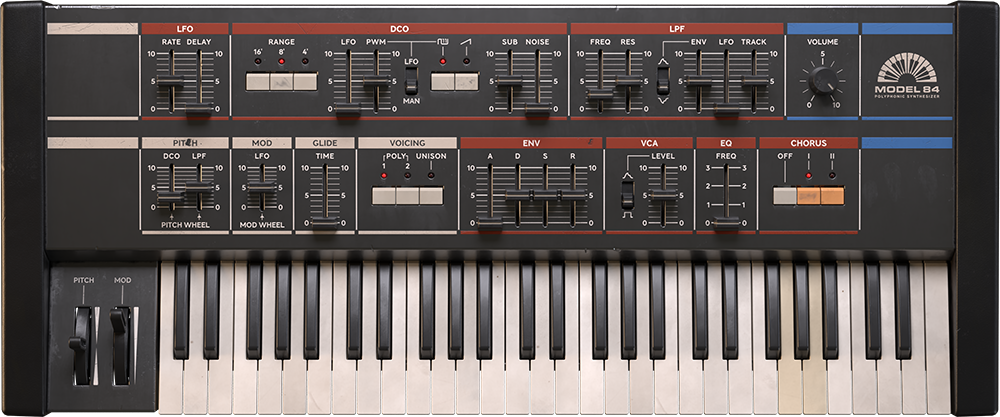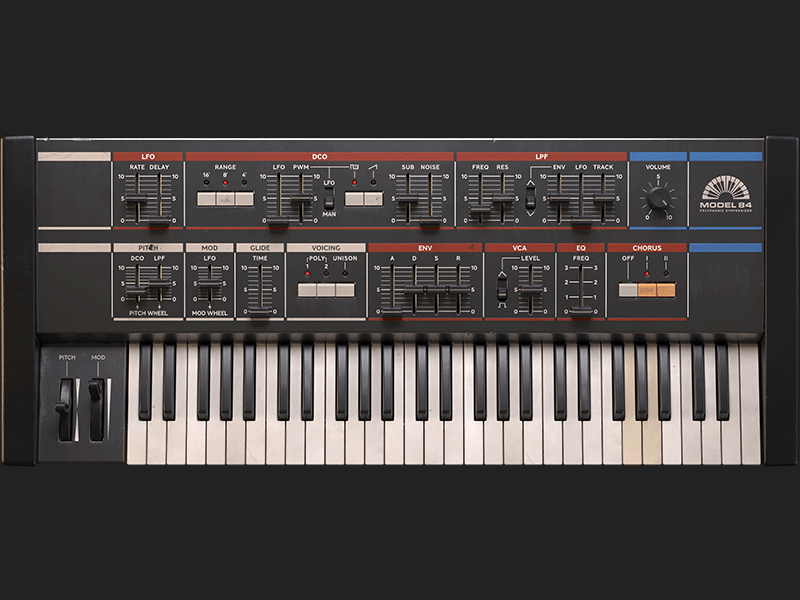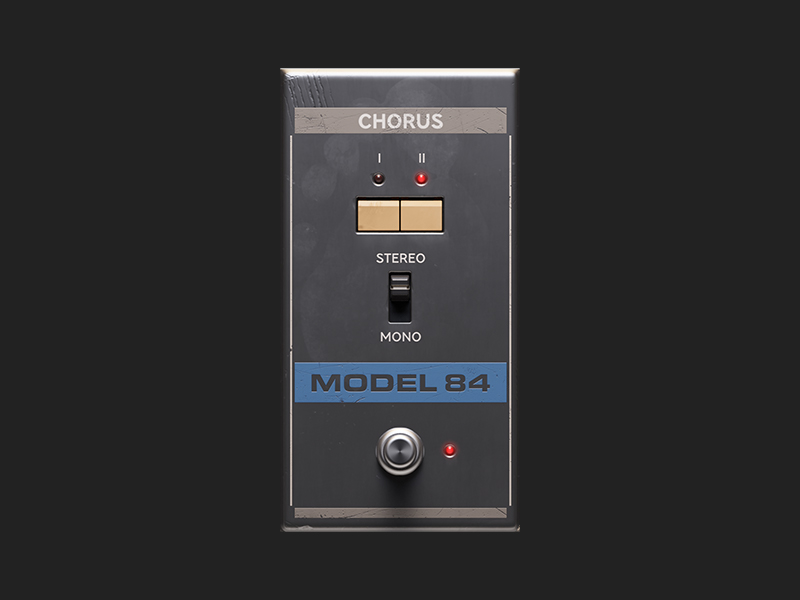Model 72 Synthesizer System
The monophonic legend, perfected.


An ’80s-era icon of polyphonic synthesizing faithfully emulated through circuit modeling on a component level
The true-to-the-original sound and unique features of the revered hardware—such as two poly modes with proper voice allocation—plus fresh innovations
Three versions included: instrument, chorus for Amp Room, and seven modules for Modular
The year is 1984. Splashing down is a majorly righteous polyphonic synthesizer that will go on to outrun its era. Thirty-odd years later, we’re still vibing on the gnarly Synthwave reverberations this paragon can produce. Used on countless records by innumerable artists, it’s a six-voice synth that set a standard and established a sound. Now it’s time to discover what it can do in the DAW.
We applied our award-winning modeling expertise to a fully-serviced and calibrated 1984 unit and the result is a perfect facsimile of the original hardware. Using rock & roll science, we’ve created a plug-in that has all the quirks and non-linearities of the 1980s-era idol. Even the clutch factory presets with easy recall of the '80s sounds heard on copious number-one hits. Added features and flexibility bring the prototype’s influential and unmistakable sound motoring into modern production environs: from our official Eurorack platform, Modular, to our pro audio guitar & bass platform, Amp Room—and beyond.
Introducing the most excellent Model 84 Polyphonic Synthesizer. The retro-future is here.

Softube has a long history of modeling professional gear. After nearly two decades working in collaboration with premium pro audio brands like Tube-Tech, Solid State Logic, Chandler Limited®, Weiss Engineering, and Trident, we have a solid track record recreating indisputable classics in software form that sound precisely like their hardware counterparts. This includes expertise in synthesizer plug-ins like Modular, Statement Lead, and Monoment Bass.
Model 84 is built on this legacy. We used the same exacting standards and skills—precise testing and experienced fine-tuning—and the outcome is sound quality that equals the hardware. Or, in terms of clarity, surpasses it. Always more, nothing less.

"It sounds just like the '80s. I love it!"



We poured the same fastidious modeling energy into Model 84 Polyphonic Synthesizer that goes into every piece of our gear. The result is voice allocation modes and an EQ—with bass boost for extra oomph on basslines—that mirror the iconic hardware. Our meticulous recreation of the unison phase allows you to assign all six voices to one note and to achieve the sounds of the synth that became an industry touchstone.

Model 84 is about control. Extended unison mode gives authority over sync and enables a more pronounced attack to the start of a note. Velocity and aftertouch support promote enhanced dynamic performance with command over the amp, as well as the filter and PW. And the expanded control panel, with added velocity and aftertouch parameters, makes it easier to fine-tune sound and behavior. Get ‘80s mojo in the digital domain—your way.

Get the authentic sound of the Decade of Greed without spending a second fussing with knobs. Model 84 comes packed with both the original presets as well as striking new artist presets. Quickly recall classic sounds, original patches, distorted bass sounds, and the Synthwave heard on so many classic and contemporary albums. Or set it to stun with incredible artist presets that range from retro sounds to modern-day fat- and wide-sounding crispy leads.

Model 84 is a highly accurate emulation of the storied polyphonic synthesizer that became a music industry staple. Every trait, trick, and mannerism of the original hardware is naow available to you in software form.
You get the unadulterated sound and behavior of the original with dead-perfect execution every time. The mod-wheel and pitch-wheel assignments affect your pitch, filter, and vibrato in the software the same as they would in the original 1980s gear. The perfectly recreated LPF tracking allows you to play the filter when self-oscillating, just like in the 1984 model unit. And the glide function gives you proper voice allocation—even when the sustain pedal is held down—encouraging wonderfully-creative playing techniques in the two poly modes. Just like the original. With the true-blue authentic Model 84 Polyphonic Synthesizer plug-in, you get the best of the quintessential '80s sound right in your DAW. No shoulder pads or feathered hair required.

From the lushness of the 1980s to today's Synthwave revival, the musical performance of this keyboard has helped it earn icon status. Our rigorous modeling of the voice modes makes for highly accurate voice allocation of chords and legato passages. The pitch and mod wheel, MIDI CC, and velocity/aftertouch support ensure it's an instrument that can be performed naturally. Use it to create the sounds this synth is so well-known for.

The super-smooth Model 84 module for Amp Room offers the powerful, dirty, and fat Chorus. The module is stellar for guitar processing and the creation of lush sounds for bass, guitar, and keyboards. Used in the original hardware and as inspiration for the design of the famous guitar stompbox, Chorus provides a “dirty chorus” sound that’s hyper-specific and prone to inciting outbursts of outrageous creative production ideas.
Model 84 for Modular offers seven fully integrated instrument sections as individual modules. Ready to add to your Eurorack system, this legendary synth inputs pure creativity and inspiration with every module. It’s simple to combine single components of the synthesizer in a modular workflow to build patches—or one monster synth patch!—and get authentically retro polyphonic sounds. With Model 84, you can create combinations in Modular that were never-before possible—via hardware or software.

The authentic sound of the 1980s in plug-in and module form
Meticulously modeled on a pristine 1984 polyphonic synthesizer
Three versions included: Model 84 Instrument, Model 84 Chorus module for Softube Amp Room, and seven Model 84 modules for Softube Modular.
The unison phase sounds of the original
Included factory presets for easy recall of classic sounds
Stunning artist presets—from classic sounds to contemporary, crispy leads
Increased velocity and aftertouch support for added control over the amp, filter, and PW
The addition of extended unison mode for higher control over sync
An expanded control panel with added parameters for fine-tuning
Pitch and mod wheel assignment, glide, and voice allocation for creative playing
